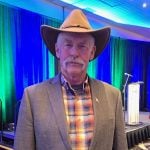ERSKINE, Alta. – George Corpataux’s moustache is solid with ice. His dark hair springs from behind long, fold-down ear flaps of his hat and his heavy Swiss Army wool coat flaps in the wind that batters the edge of his corrals. The warmest thing he wears is his broad grin.
“It is good to be my own boss now,” said George, who still struggles with English.
Ursula, George and their two daughters are new Canadians who emigrated from Switzerland last fall after purchasing a central Alberta ranch.
Read Also

Chinese, Indian tariffs take toll on pea prices
The disruption of pea exports from Canada’s largest customers will likely result in slow pea exports for the remainder of the crop year.
Sandam Charolais was owned by red Charolais breeder Don Poch-yiko before the Corpatauxes bought the operation.
“We wanted a working farm, complete and a deal to work with the previous owners until we could run it on our own and that is what we got,” said Ursula.
She and George planned the move for 11 years, saving money from their regular jobs as well as income from an alpine sleigh ride business, horse training and a tiny mountain farm.
“We planned, we saved, we lived very poor so we could come here. We sold everything but our clothes, personal effects and the girls’ toys. … We are committed now and can’t go back,” said Ursula.
Preferred exotic breeds
The couple had a plan to raise colored cattle. They knew that North American commercial cattle producers were paying a premium for color in their animals but still wanted the desirable features of the exotic breeds. The red Charolais farm was just the genetic start they needed as a base to produce a black pigment Charolais line, the darker the better.
The Sandam herd was 50 cows, 30 heifers and a crop of calves. That was not enough to accomplish the challenging eight-year goal of a black herd the couple had set for themselves. An additional 92 dark heifers were purchased from a Montana ranch but, without a dark bull, the project could not succeed.
Granada’s Red Ace would secure their breeding line. At a sale in early December 1995, little more than a month after settling in their new home, they paid the North American high price for a Charolais bull. At a Saturday sale in Red Deer, Alta., $110,000 changed hands and the new immigrants were new owners.
Ursula knew Alberta was the future for her family. In 1984, as a foreign exchange student, she had spent nine months on a beef farm and treasured the experience. Both she and George had been born into farming, but Swiss farmers need huge amounts of capital to pass on a family operation.
“For the price of a farm in Canada we could buy a house on three or four acres in Switzerland. … To farm we had to leave,” said Ursula.
They had heard horror stories of newcomers losing their investments so they chose a broker who had been an immigrant. Ursula also had the benefit of a second cousin in Nanton, Alta., and other relatives in the U.S plains.
“It must be in our blood to come here,” she said.
Searching for a year the couple had hoped to buy a commercial cattle business, but found nothing that suited them. The fifth birthday of their oldest daughter made them re-examine information they had found on the purebred business and the ranch for sale at Erskine. It was May 1995 and if she was to start school in Canada they would have to move quickly.
“Strong Swiss currency meant we could do more than we had planned so we decided the time was right,” she said.
“Back there our girls could not be outside. Roads come right to the door, there are people everywhere. Here there is nothing but space, they can play where they like, the farms here are much safer. People here don’t know how good it is for farmers and their families. This land must be cherished.”
The land they needed to support the increased herd would exceed the section they purchased with the ranch. Renting another half section the couple now has enough land to cherish and enough cattle to fill the pastures. The Corpatauxes say they could afford to buy more land but prefer to keep cash in reserve for unexpected costs or opportunities.
“It is like any good business, you need a plan. But if it is a farm, you must want it with everything you’ve got,” she said.














